Gallery of Unique Restored Structures
Aloha Stadium, Hawaii
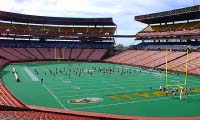
Built in 1975, Aloha Stadium was designed by architect Charles Luckman, who also designed Madison Square Garden and Kennedy Space Center. Aloha Stadium is the largest sports facility in Hawaii. The stadium has a system of air cushions, which allow large moveable sections of Aloha Stadium to be reconfigured for different sporting events and concerts. Aloha Stadium was the first facility in the United States with this capability.
Since 1987, Abhe & Svoboda, Inc. has completed several rehabilitation projects at Aloha Stadium. The major project, performed in 1993, was a $13.76 million rehabilitation contract to repair the SE moveable section, N fixed stands, and the pedestrian bridge. All of the work on this large project was accomplished in the time period of 100 working days.
Work consisted of abrasive blasting and painting the structural steel, which contained lead-based paint. SSPC Class 1A negative air containment systems were utilized for the abrasive blasting and painting operations. Some of the containment platforms were as high as 170 feet off the stadium floor. The coating system applied to the structural steel was an Ameron manufactured zinc rich epoxy primer, epoxy intermediate, and urethane topcoat system.
This project also involved extensive steel repair and replacement including steel seat plate renovation, replacing metal form decking, and replacing siding and roof decking. Additional work included renovation of the press box area, and minor electrical and mechanical work.
Since 1987, Abhe & Svoboda, Inc. has completed several rehabilitation projects at Aloha Stadium. The major project, performed in 1993, was a $13.76 million rehabilitation contract to repair the SE moveable section, N fixed stands, and the pedestrian bridge. All of the work on this large project was accomplished in the time period of 100 working days.
Work consisted of abrasive blasting and painting the structural steel, which contained lead-based paint. SSPC Class 1A negative air containment systems were utilized for the abrasive blasting and painting operations. Some of the containment platforms were as high as 170 feet off the stadium floor. The coating system applied to the structural steel was an Ameron manufactured zinc rich epoxy primer, epoxy intermediate, and urethane topcoat system.
This project also involved extensive steel repair and replacement including steel seat plate renovation, replacing metal form decking, and replacing siding and roof decking. Additional work included renovation of the press box area, and minor electrical and mechanical work.
Cape Newenham Long Range Radar Station, Alaska
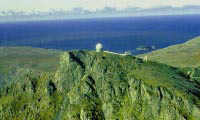
Cape Newenham is located in western Alaska on a remote section of the Bering Sea coastline. In the early 1950's the U.S. Air Force built a Long Range Radar facility at the site, which was one of the original air traffic control and warning sites of the Alaskan air defense system. In 1986, the U.S Air Force installed a Minimally Attended Radar System (MARS) tower on a mountain top overlooking Cape Newenham.
Over time, the harsh Bering Sea weather and exposure to the elements took its toll on the radar facility and repairs were required. In the summer of 1997, Abhe & Svoboda, Inc. rehabilitated the MARS tower. The repair work included; refurbishing the support structure, concrete repair, structural steel modification, and installing new exterior walls/metal siding. The work was conducted at a very remote site with limited facilities. All materials were flown in or barged in.
The repairs helped ensure the safeguard of the $17 million surveillance radar housed in the MARS tower well into the next century.
Kings Bay Naval Submarine Base Explosives Handling Wharf, Georgia
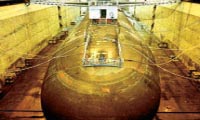
Explosives Handling Wharf #1 is located at the Naval Submarine Base in Kings Bay, Georgia. The Base is the Atlantic home port for U.S. Trident ballistic missile submarines.
Explosives Handling Wharf #1 is the larger of two facilities at the base, which are used to berth submarines and perform missile swap-outs. The dimensions of the enormous building are 527 feet long, by 238 feet wide, and 144 feet high.
This project consisted of completely removing the existing coating system on all the interior structural roof support steel, but did not include any of the roof deck coating. Abhe & Svoboda, Inc. abrasive blasted and painted 288,000 square feet of roof support structural steel.
The contract also included replacing the existing building gutter system with 2,100 lineal feet of a new stainless steel gutter/flashing system.
Abhe & Svoboda, Inc. was the prime contractor and overall construction manager on this contract. Due to the overall scope of the work, Abhe & Svoboda, Inc. performed 100% of the on-site work with its own forces. Some structural design work was subcontracted for the containments utilized.
Explosives Handling Wharf #1 is the larger of two facilities at the base, which are used to berth submarines and perform missile swap-outs. The dimensions of the enormous building are 527 feet long, by 238 feet wide, and 144 feet high.
This project consisted of completely removing the existing coating system on all the interior structural roof support steel, but did not include any of the roof deck coating. Abhe & Svoboda, Inc. abrasive blasted and painted 288,000 square feet of roof support structural steel.
The contract also included replacing the existing building gutter system with 2,100 lineal feet of a new stainless steel gutter/flashing system.
Abhe & Svoboda, Inc. was the prime contractor and overall construction manager on this contract. Due to the overall scope of the work, Abhe & Svoboda, Inc. performed 100% of the on-site work with its own forces. Some structural design work was subcontracted for the containments utilized.
Indianapolis Motor Speedway Grandstand "B", Indiana
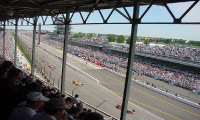
The Indianapolis Motor Speedway is home to the famous Indianapolis 500 auto race. The massive facility can accommodate 400,000 spectators. With a seating capacity almost three times the world's largest soccer stadium, it is by far the largest sporting venue in the world.
Built in 1909, it is the second oldest race track in the world. It is listed on the National Register of Historic Places and designated as a National Historic Landmark. The Grandstand "B" area located at Turn One of the race track is part of the original structure.
In 2004 Abhe & Svoboda, Inc. painted the Grandstand "B" area of the race track.
Built in 1909, it is the second oldest race track in the world. It is listed on the National Register of Historic Places and designated as a National Historic Landmark. The Grandstand "B" area located at Turn One of the race track is part of the original structure.
In 2004 Abhe & Svoboda, Inc. painted the Grandstand "B" area of the race track.
Mokelumne Aqueduct, California
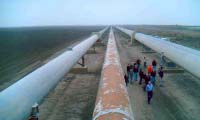
The East Bay Municipal Utility District provides water to 1.3 million customers in the San Francisco Bay Area via a network of reservoirs, aqueducts, treatment plants and other distribution facilities. The main source of water is the Pardee Reservoir in the Mokelumne River watershed.
The Mokelumne Aqueduct System includes three parallel elevated steel pipelines, which carry water from the Pardee Reservoir in the Sierra Nevada foothills to storage reservoirs near Oakland. Aqueduct #1 is 61 inches in diameter, Aqueduct #2 has a diameter of 67 inches, and Aqueduct #3 is the largest with a diameter of 87 inches.
Abhe & Svoboda, Inc. abrasive blasted 2.5 miles of the failing coating on Aqueduct #2 using a recyclable steel grit.
The Mokelumne Aqueduct System includes three parallel elevated steel pipelines, which carry water from the Pardee Reservoir in the Sierra Nevada foothills to storage reservoirs near Oakland. Aqueduct #1 is 61 inches in diameter, Aqueduct #2 has a diameter of 67 inches, and Aqueduct #3 is the largest with a diameter of 87 inches.
Abhe & Svoboda, Inc. abrasive blasted 2.5 miles of the failing coating on Aqueduct #2 using a recyclable steel grit.
Honolulu Harbor Pier 2, Hawaii
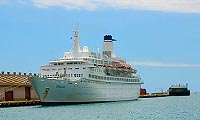
Abhe & Svoboda, Inc. completed a major rehabilitation project at Pier 2, which included extensive concrete spall repair & fender replacement. The project was part of a larger project to renovate Pier 2 to meet the need for a modern cruise ship terminal with in Honolulu Harbor.
Work underneath the pier was performed from a barge and floating access platform designed and built by Abhe & Svoboda, Inc. A Conjet robot was utilized for ultrahigh-pressure hydro-demolition in the large flat soffit areas, and jack hammers were used to remove concrete in less accessible areas. The existing coal tar mastic coating was removed by abrasive blasting with coal slag. A new Carbondale epoxy coating was applied. New rubber fenders were also installed.
Work underneath the pier was performed from a barge and floating access platform designed and built by Abhe & Svoboda, Inc. A Conjet robot was utilized for ultrahigh-pressure hydro-demolition in the large flat soffit areas, and jack hammers were used to remove concrete in less accessible areas. The existing coal tar mastic coating was removed by abrasive blasting with coal slag. A new Carbondale epoxy coating was applied. New rubber fenders were also installed.
Yaquina Head Lighthouse, Oregon
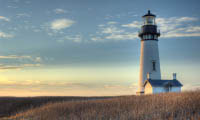
'Built in 1871, the Yaquina Head Lighthouse is the second oldest lighthouse in Oregon. The light house is also the tallest lighthouse in the State.
In 2006, Abhe & Svoboda, Inc. conducted a major top-to-bottom restoration of the historic landmark. The lighthouse and adjoining oil house were fully restored to their original condition and appearance.
Scaffolding and containment systems were erected around the entire 93 foot tall structure. The metal and mortar exterior was abrasive blasted. The exterior was painted with mold and mildew resistant high-tech coatings. The exterior was painted in its original colors. In addition to coatings work, damaged cast iron parts were replaced, and new windows were installed in the lantern house.
During the restoration work, the lighthouse's lens was wrapped in a protective covering, and a temporary lamp was fixed to the top of the containment to aid ships in navigation. Extreme care was taken not to damage the lighthouses lens, which is the original Fresnel lens from 1873.
In 2006, Abhe & Svoboda, Inc. conducted a major top-to-bottom restoration of the historic landmark. The lighthouse and adjoining oil house were fully restored to their original condition and appearance.
Scaffolding and containment systems were erected around the entire 93 foot tall structure. The metal and mortar exterior was abrasive blasted. The exterior was painted with mold and mildew resistant high-tech coatings. The exterior was painted in its original colors. In addition to coatings work, damaged cast iron parts were replaced, and new windows were installed in the lantern house.
During the restoration work, the lighthouse's lens was wrapped in a protective covering, and a temporary lamp was fixed to the top of the containment to aid ships in navigation. Extreme care was taken not to damage the lighthouses lens, which is the original Fresnel lens from 1873.
